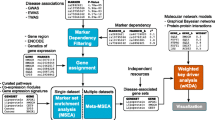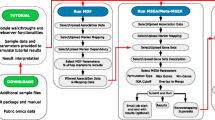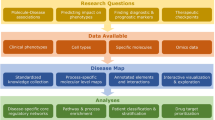Abstract
Genome-wide analyses such as DNA microarray, RNA sequencing and RNA interference-based high-throughput screening are prevalent to decipher a biological process of interest, and provide a large quantity of data to be processed. An ultimate goal for researchers must be extrapolation of their data to human diseases. We have conducted functional genome-wide screenings to elucidate molecular mechanisms of the inflammation amplifier, a NFκB/STAT3-dependent machinery that potently drives recruitment of immune cells to promote inflammation. Using a public database of genome-wide association studies (GWAS), we recently reported the reverse-direction method by which our mass screening data were successfully linked to many human diseases. As an example, the epiregulin–epidermal growth factor receptor pathway was identified as a regulator of the inflammation amplifier, and associated with human diseases by GWAS. In fact, serum epiregulin levels were higher in patients with chronic inflammatory disorders. The reverse-direction method can be a useful tool to narrow mass data down to focus on human disease-related genes.



Similar content being viewed by others
References
Adachi Y, Aoki C, Yoshio-Hoshino N et al (2006) Interleukin-6 induces both cell growth and VEGF production in malignant mesotheliomas. Int J Cancer 119:1303–1311
Allen SJ, Crown SE, Handel TM (2007) Chemokine: receptor structure, interactions, and antagonism. Annu Rev Immunol 25:787–820
Arima Y, Harada M, Kamimura D et al (2012) Regional neural activation defines a gateway for autoreactive T cells to cross the blood–brain barrier. Cell 148:447–457
Atsumi T, Ishihara K, Kamimura D et al (2002) A point mutation of Tyr-759 in interleukin 6 family cytokine receptor subunit gp130 causes autoimmune arthritis. J Exp Med 196:979–990
Atsumi T, Sato M, Kamimura D et al (2009) IFN-gamma expression in CD8+ T cells regulated by IL-6 signal is involved in superantigen-mediated CD4+ T cell death. Int Immunol 21:73–80
D’Acquisto F, Iuvone T, Rombolà L et al (1997) Involvement of NF-kappaB in the regulation of cyclooxygenase-2 protein expression in LPS-stimulated J774 macrophages. FEBS Lett 418:175–178
Ferrand A, Kowalski-Chauvel A, Bertrand C et al (2005) A novel mechanism for JAK2 activation by a G protein-coupled receptor, the CCK2R: implication of this signaling pathway in pancreatic tumor models. J Biol Chem 280:10710–10715
Hamdani N, Tamouza R, Leboyer M (2012) Immuno-inflammatory markers of bipolar disorder: a review of evidence. Front Biosci 4:2170–2182
Jo EJ, Lee HY, Lee YN et al (2004) Group IB secretory phospholipase A2 stimulates CXC chemokine ligand 8 production via ERK and NF-kappa B in human neutrophils. J Immunol 173:6433–6439
Kaiser WJ, Upton JW, Mocarski ES (2008) Receptor-interacting protein homotypic interaction motif-dependent control of NF-kappa B activation via the DNA-dependent activator of IFN regulatory factors. J Immunol 181:6427–6434
Kitamura H, Kamon H, Sawa S et al (2005) IL-6-STAT3 controls intracellular MHC class II alphabeta dimer level through cathepsin S activity in dendritic cells. Immunity 23:491–502
Kojima M, Morisaki T, Izuhara K et al (2000) Lipopolysaccharide increases cyclo-oxygenase-2 expression in a colon carcinoma cell line through nuclear factor-kappa B activation. Oncogene 19:1225–1231
Korn T, Bettelli E, Oukka M et al (2009) IL-17 and Th17 cells. Annu Rev Immunol 27:485–517
Lander ES (2011) Initial impact of the sequencing of the human genome. Nature 470:187–197
Lee J, Nakagiri T, Oto T et al (2012) IL-6 amplifier, NF-kappaB-triggered positive feedback for IL-6 signaling, in grafts is involved in allogeneic rejection responses. J Immunol 189:1928–1936
Lee J, Nakagiri T, Kamimura D et al (2013) IL-6 amplifier activation in epithelial regions of bronchi after allogeneic lung transplantation. Int Immunol 25:319–332
Murakami M, Hirano T (2012) The pathological and physiological roles of IL-6 amplifier activation. Int J Biol Sci 8:1267–1280
Murakami M, Okuyama Y, Ogura H et al (2011) Local microbleeding facilitates IL-6- and IL-17-dependent arthritis in the absence of tissue antigen recognition by activated T cells. J Exp Med 208:103–114
Murakami M, Harada M, Kamimura D et al (2013) Disease-association analysis of the IL-6-amplifier, an inflammation-related feedback loop. Cell Rep 3:946–959
Ogura H, Murakami M, Okuyama Y et al (2008) Interleukin-17 promotes autoimmunity by triggering a positive-feedback loop via interleukin-6 induction. Immunity 29:628–636
Park SJ, Nakagawa T, Kitamura H et al (2004) IL-6 regulates in vivo dendritic cell differentiation through STAT3 activation. J Immunol 173:3844–3854
Pastore S, Mascia F, Mariani V et al (2008) The epidermal growth factor receptor system in skin repair and inflammation. J Invest Dermatol 128:1365–1374
Pickell L, Tran P, Leclerc D et al (2005) Regulatory studies of murine methylenetetrahydrofolate reductase reveal two major promoters and NF-kappaB sensitivity. Biochim Biophys Acta 1731:104–114
Rojo AI, Salinas M, Martín D et al (2004) Regulation of Cu/Zn-superoxide dismutase expression via the phosphatidylinositol 3 kinase/Akt pathway and nuclear factor-kappaB. J Neurosci 24:7324–7334
Sawa S, Kamimura D, Jin GH et al (2006) Autoimmune arthritis associated with mutated interleukin (IL)-6 receptor gp130 is driven by STAT3/IL-7-dependent homeostatic proliferation of CD4+ T cells. J Exp Med 203:1459–1470
Schmitz T, Souil E, Hervé R et al (2007) PDE4 inhibition prevents preterm delivery induced by an intrauterine inflammation. J Immunol 178:1115–1121
Song YJ, Jen KY, Soni V et al (2006) IL-1 receptor-associated kinase 1 is critical for latent membrane protein 1-induced p65/RelA serine 536 phosphorylation and NF-kappaB activation. Proc Natl Acad Sci USA 103:2689–2694
Tabas I, Glass CK (2013) Anti-inflammatory therapy in chronic disease: challenges and opportunities. Science 339:166–172
Thomas RS, Tymms MJ, McKinlay LH et al (1997) ETS1, NFkappaB and AP1 synergistically transactivate the human GM-CSF promoter. Oncogene 14:2845–2855
Wolf I, Pevzner V, Kaiser E et al (1998) Downstream activation of a TATA-less promoter by Oct-2, Bob1, and NF-kappaB directs expression of the homing receptor BLR1 to mature B cells. J Biol Chem 273:28831–28836
Author information
Authors and Affiliations
Corresponding author
About this article
Cite this article
Ogura, H., Atsumi, T., Bando, H. et al. The Reverse-Direction Method Links Mass Experimental Data to Human Diseases. Arch. Immunol. Ther. Exp. 62, 41–45 (2014). https://doi.org/10.1007/s00005-013-0255-9
Received:
Accepted:
Published:
Issue Date:
DOI: https://doi.org/10.1007/s00005-013-0255-9




